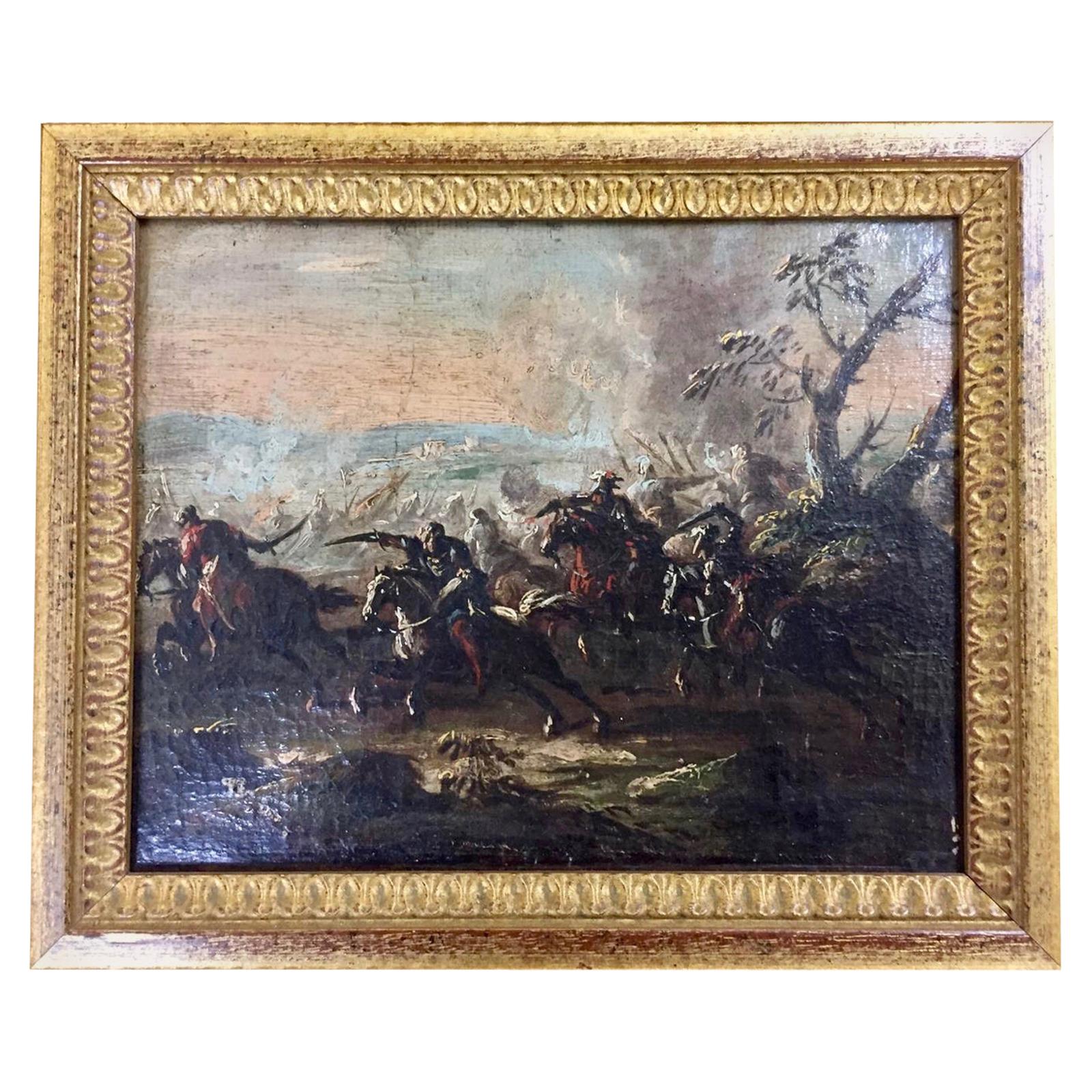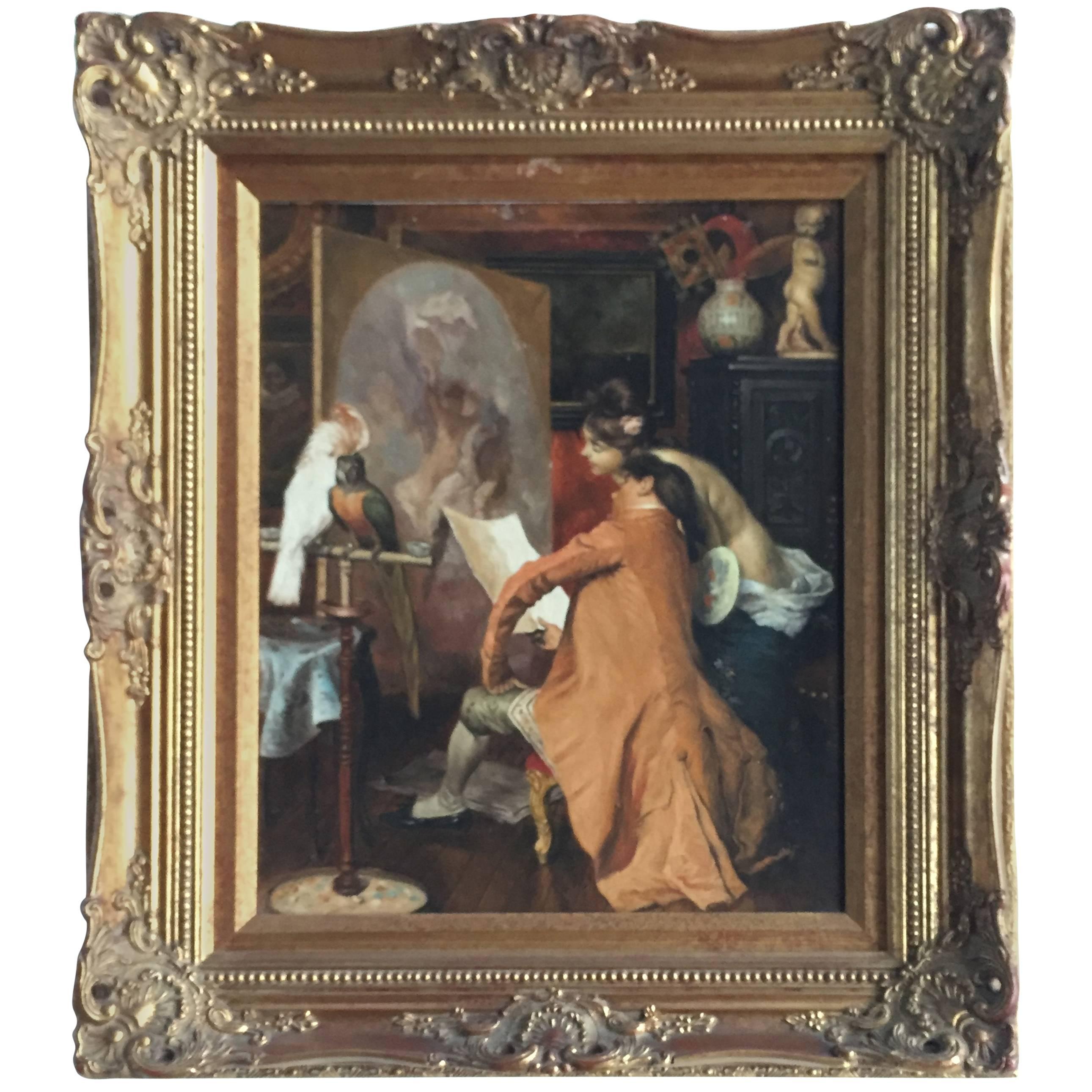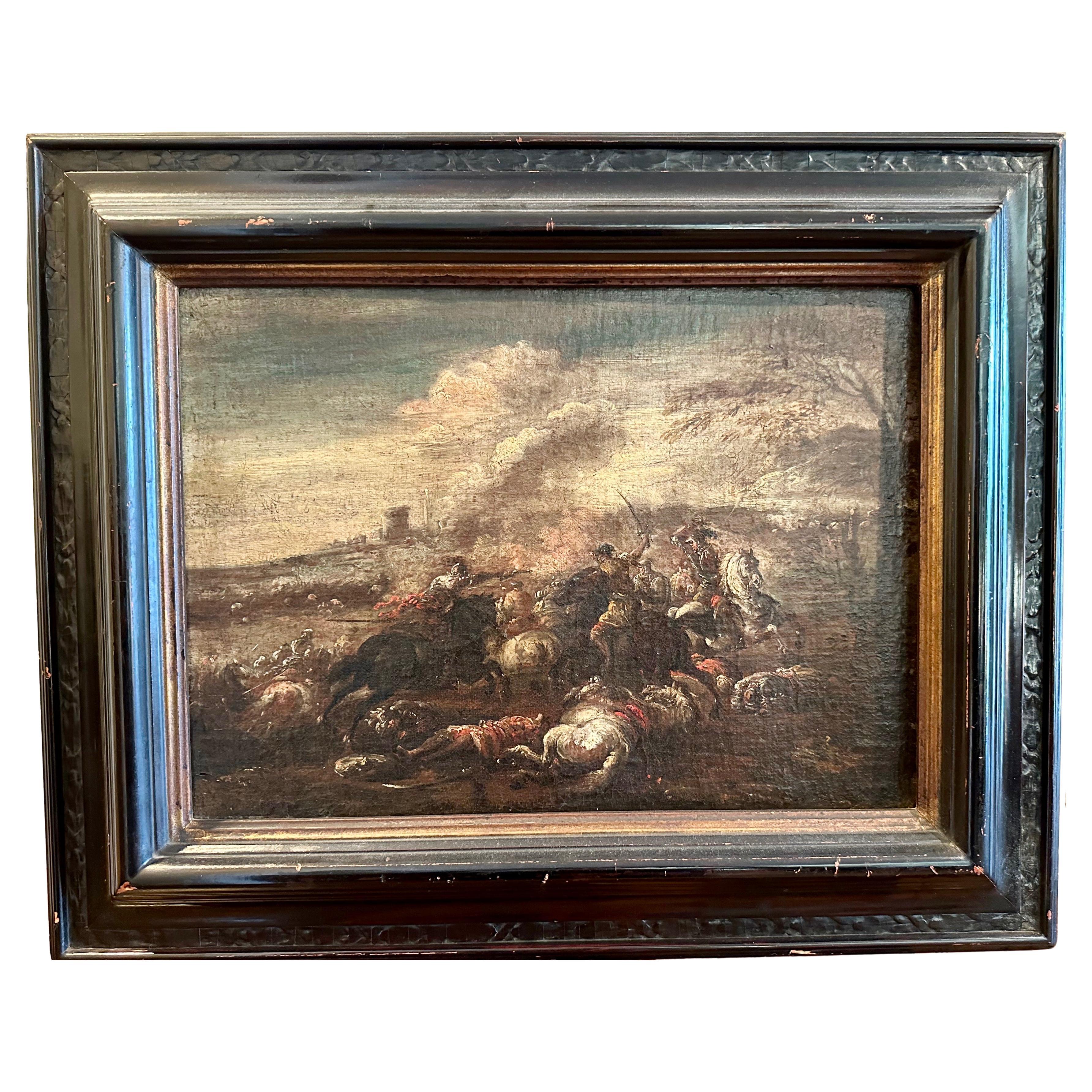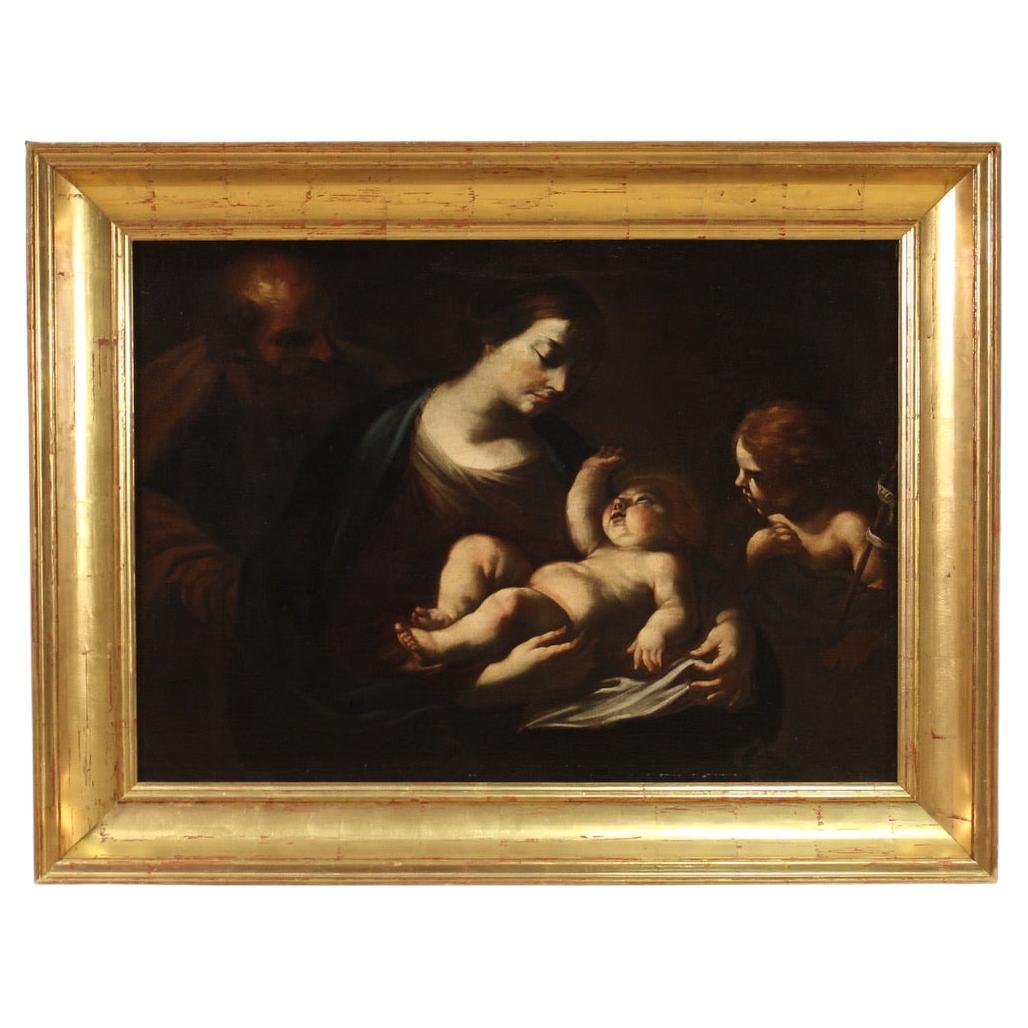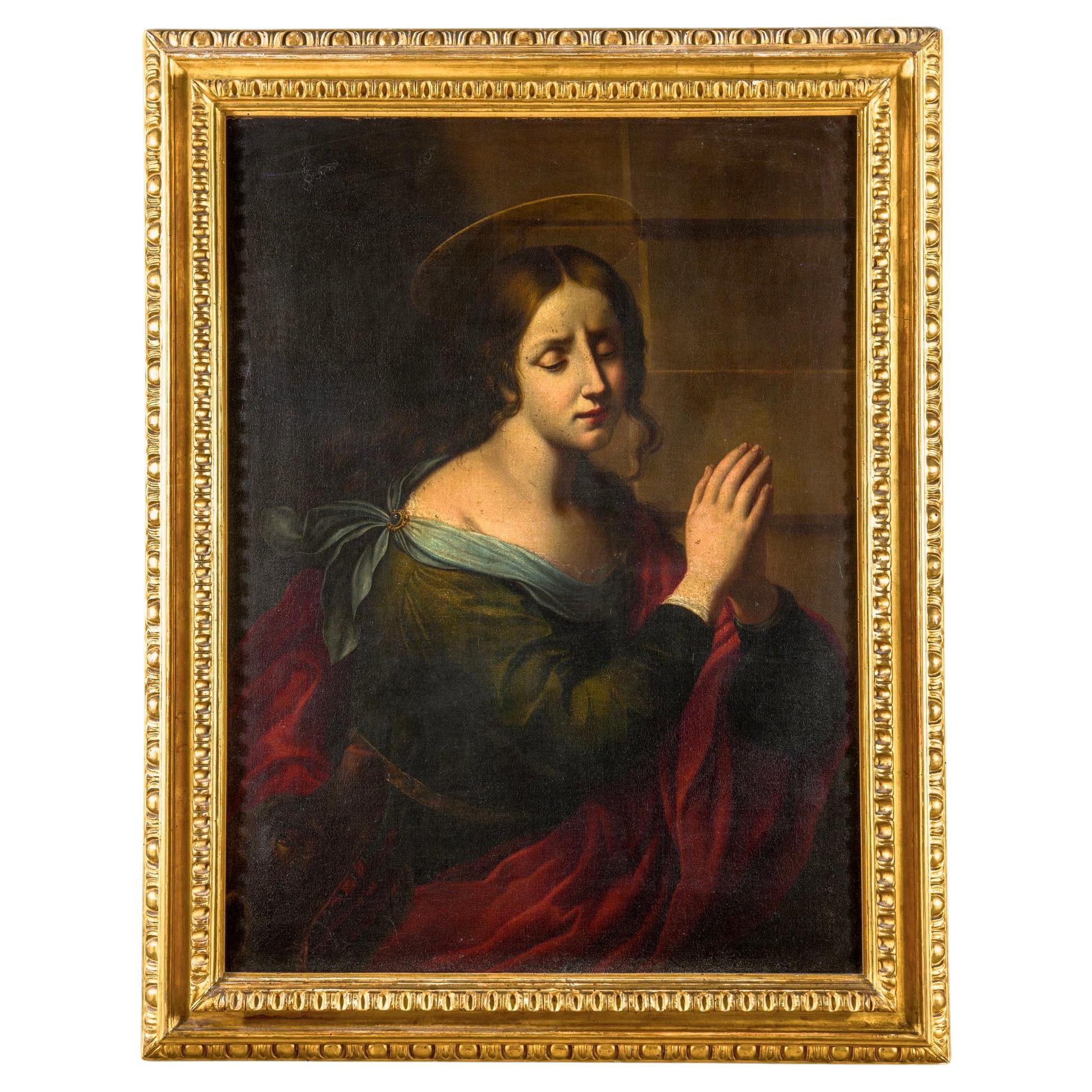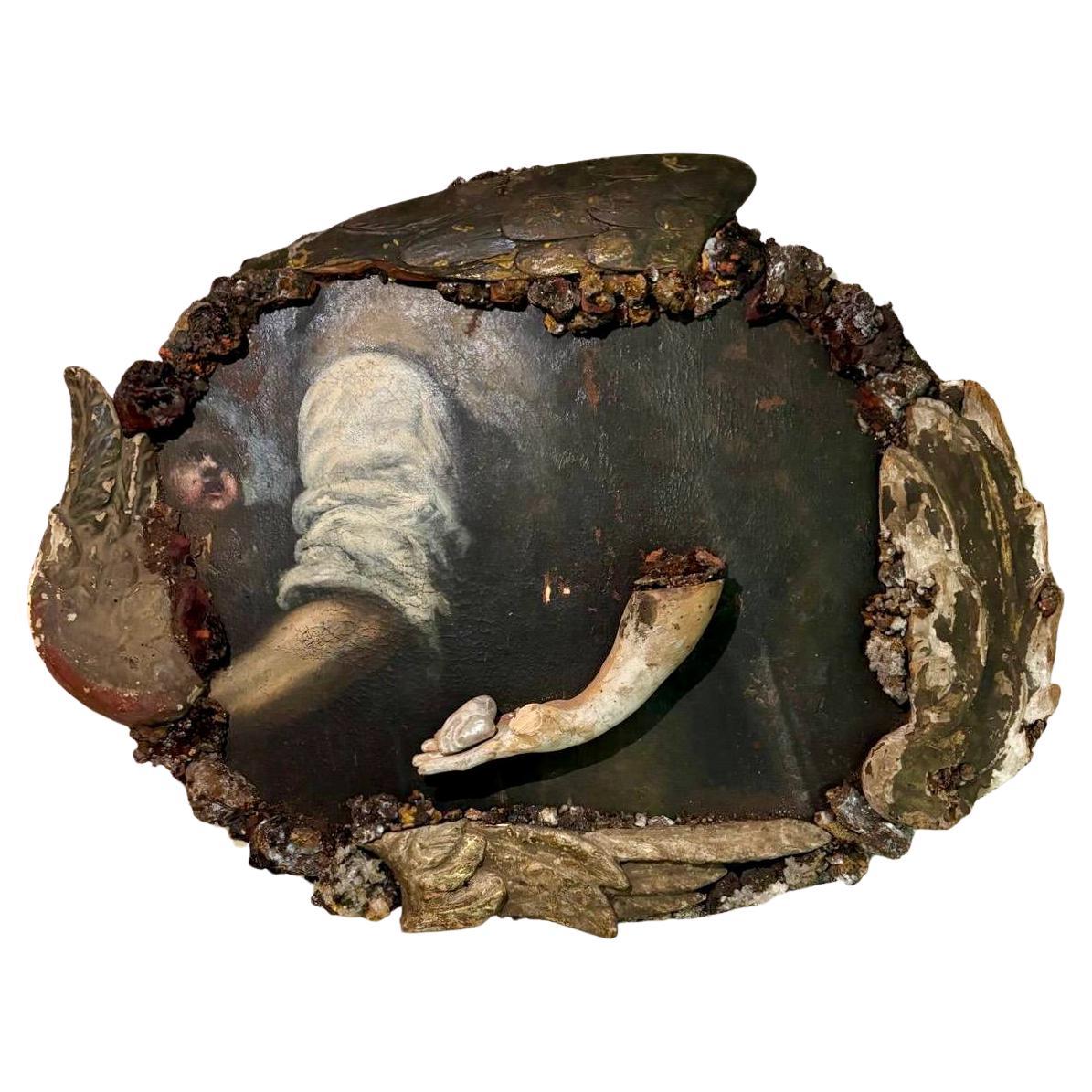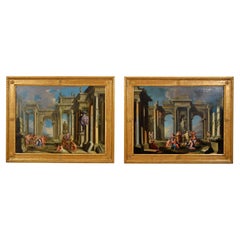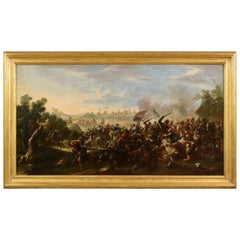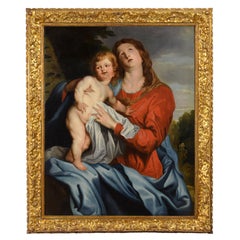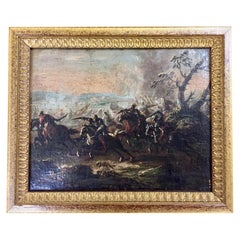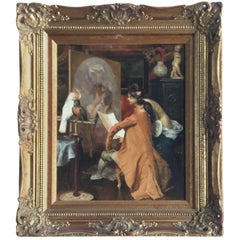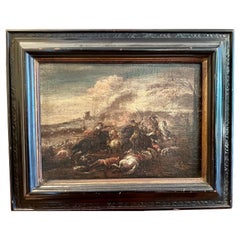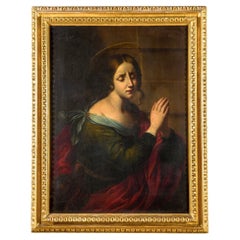Items Similar to 17th Century, Italian Painting by Pier Francesco Cittadini, Jacob and his Family
Want more images or videos?
Request additional images or videos from the seller
1 of 13
17th Century, Italian Painting by Pier Francesco Cittadini, Jacob and his Family
About the Item
Pier Francesco Cittadini (Milan, 1616-Bologna, 1681)
"Jacob and his family go to Egypt"
Oil on canvas, cm 109 x 190 (canvas only)
The valuable painting, made in oil on canvas, depicts Jacob and his family go to Egypt and we believe it can be, given the high quality painting, autograph work of Italian Pier Francesco Cittadini (Italy Milan, 1616 - Bologna, 1681) made after 1647. The work, in excellent condition is accompanied by a coeval frame in wood finely carved and golden.
The scene depicted, which was confused with the Flight to Egypt in the past years, is instead identified with the biblical episode of Jacob’s journey. In the foreground, reading the painting from left to right, we see a caravan composed of animals, including donkeys, dromedaries, goats, dogs and horses and people, women, men and slaves, who carry on their journey along the banks of a river, following a path that to the right, would seem to lead to the through of a bridge. In addition to the watercourse is described an environment characterized by large rocks and impervious come far to cover the entire verticality of the canvas. On the left, in the distance, we see the tail of the caravan that runs along the steep path. Large trees enliven and harmonize the environment, as well as white and grey clouds characterize the predominantly clear sky and illuminated on the right by sunlight.
The story is told in the Bible, Book of Genesis, 30, 25, passage in which is described the flight of Jacob from Haran after the contrasts with Laban, father of his wife Rachel. Jacob is the third great patriarch of the Bible. From his descendants originate the twelve generations of the people of Israel. He is the son of Isaac and Rebekah, who led him to flee from the wrath of Esau to Haran to seek refuge from his brother, Laban. At his uncle’s house Jacob met his daughter Rachel. As soon as he saw his cousin, Jacob was taken. Jacob will stay seven years in the service of Laban to marry his beloved Rachel. But Laban, with a deception, will give him in marriage first Lia, the least beautiful eldest daughter, and only after another seven years the splendid Rachel. From his first wife he will have several children, while Rachel will give birth to the beloved son, Joseph, who will become viceroy of Egypt.
After years of service, Jacob asked to be paid with every dark-coloured garment among the sheep and every spotted and dotted garment among the goats. Laban accepted and sent away from his sons all the leaders of that kind. So Jacob took fresh branches of poplar, almond and plane tree, and flayed them, and put them in the troughs. The optical suggestion induced the goats and the sheep to conceive and give birth to dark, striped and dotted garments. He also ensured that all the strongest and healthiest leaders of the flock of Laban would drink near the barked branches, thus assuring a genetic superiority to his part of the flock. His flocks grew numerous and strong and he became richer than his relative, arousing envy. It was clear that Laban would not respect him much longer. At the suggestion of the Lord, Jacob decided to return to Canaan. Trying to avoid any possible dispute, he left with his family while Laban was absent for shearing sheep. But when, three days later, his uncle returned home, he became angry, feeling offended because Jacob had gone secretly and had not allowed him to greet his daughters and grandchildren. In addition, his teraphim, statuettes, or idols, which depicted the family deities, had disappeared. After 7 days of pursuit, Laban and his men reached Jacob’s group on Mount Gilead, in the mountainous region west of the Euphrates River, where his uncle and grandson had a stormy conversation. The younger man was outraged at being accused of stealing idols and told Labano to rummage through his family’s tents at will. Neither of them could know or even imagine that it was Rachel who took the idols and hid them in the saddle of the camel. During the search, she sat down firmly on the saddle, apologizing for not being able to get up, «because I usually have what happens to women» (Gen 31:35). So the loot wasn’t discovered.
The author of this work was inspired by the composition of an engraving by Stefano Della Bella (1610-1664) of circa 1647. The engraving by Stefano della Bella bears the title "Iacob sur ses vieux jours quitte sans fascherie pour voir son filz Ioseph, sa terre et sa patrie" and is signed on the bottom left "Stef. of the Beautiful In. et fe." while on the right it is declared "Cum privil. Regis", that is with license of the king.
Stefano Della Bella (Italy - Florence, May 18, 1610-Florence, July 12, 1664) was born in a family of painters, sculptors and goldsmiths and was left early orphan of his father sculptor, he dedicated himself first to the art of goldsmith at the school of Giovanni Benedetto Castiglione and Gasparo Mola, then turning his attention to drawing and engraving. He soon began drawing figures and copying the etchings of Jacques Callot, which inspired his early works. Under the protection of the Medici, in particular of Don Lorenzo, cadet son of Grand Duke Ferdinand I, Della Bella has the opportunity to make study trips to Rome, where he stayed from 1633-1636; In Rome he met French engravers and publishers of prints such as Israël Henriet and François Langlois, who influenced his decision to move to Paris in 1639, four years after the death of Callot. In Paris he soon reached, thanks to the engravings commissioned by Cardinal Richelieu, the success also worldly; he frequented courtiers, theatre artists and writers, while refusing too oppressive honors. In 1646-1647 he continued his travels in the Netherlands to Amsterdam, Antwerp and Dordrecht. He returned to Florence in 1650 and resumed working under the protection of the Medici court, working for his patrons. In 1656 he became a member of the Academy of Apatists.
The painting object of this study is reasonably attributable to Pier Francesco Cittadini, or Pierfrancesco Cittadini, called the Milanese or the Franceschino (Italy - Milan, 1616-Bologna, 1681) as some exemplary stylistic comparisons proposed to follow can prove.
Pier Francesco Cittadini was an Italian baroque painter, mainly active in Bologna.
His artistic training first took place with the painter Daniele Crespi; later in 1634 he moved to Bologna, where he followed the teachings of Guido Reni. He then moved to Rome, where he obtained commissions also from Louis XIV, thanks to the success he had with still lifes and landscapes.
In 1650, he returned to Bologna, where on 19 June 1653 he married Giulia Ballarini, with whom he had many children and of whom at least three, Carlo Antonio, Angelo Michele, Giovanni Battista, followed in his father’s footsteps. His works are preserved in important museums and collections such as Villa Estense di Sassuolo, Bologna, coll. Giovannini, Galleria Estense di Modena, Pinacoteca civica di Bologna, Galleria nazionale d'arte antica di Trieste, Pinacoteca civica di Forlì.
The painting in question, of high pictorial quality, certainly belongs to the body of important works of the artist, in which we find depicted the female figure with the turban that the painter likes to insert several times in his paintings.
Characteristic is also the color palette, characterized by saturated colors, bright and full, as well as the special treatment of the sky with clouds streaked and blue intense.
Observing the setting of the canvas in question and the description of the landscape, the rocky reliefs and the games of the most perspective levels it is possible to propose some similar layout, in which there are also subjects that lend themselves to a similar description, such as caravans of wayfarers and herds or the "Return from Egypt" of the Puskin Museum.
Also interesting is a Citizen’s China Drawing, kept at the Royal Collection Trust, in which a study for a landscape seems very close to the one then depicted in the canvas, with trees that act as a backdrop to the scene, large rocky reliefs arranged in a way very similar to the final version. It is understood that for the Citizens there is an authentic feeling of the landscape, felt as a protagonist not secondary to the figures.
In conclusion, the work, in good condition, is attributable to Pier Francesco Cittadini and datable following the engraving of Stefano Della Bella in 1647, probably made after the return to Bologna of the artist (1650). The canvas is therefore added to the body of works of a representative painter in the development of Baroque painting, especially that of Bologna.
We apologize for any errors in translation from Italian.
- Dimensions:Height: 57.09 in (145 cm)Width: 84.26 in (214 cm)Depth: 3.94 in (10 cm)
- Style:Baroque (Of the Period)
- Materials and Techniques:
- Place of Origin:
- Period:Mid-17th Century
- Date of Manufacture:Mid-17th Century
- Condition:Wear consistent with age and use.
- Seller Location:IT
- Reference Number:1stDibs: LU4405222557482
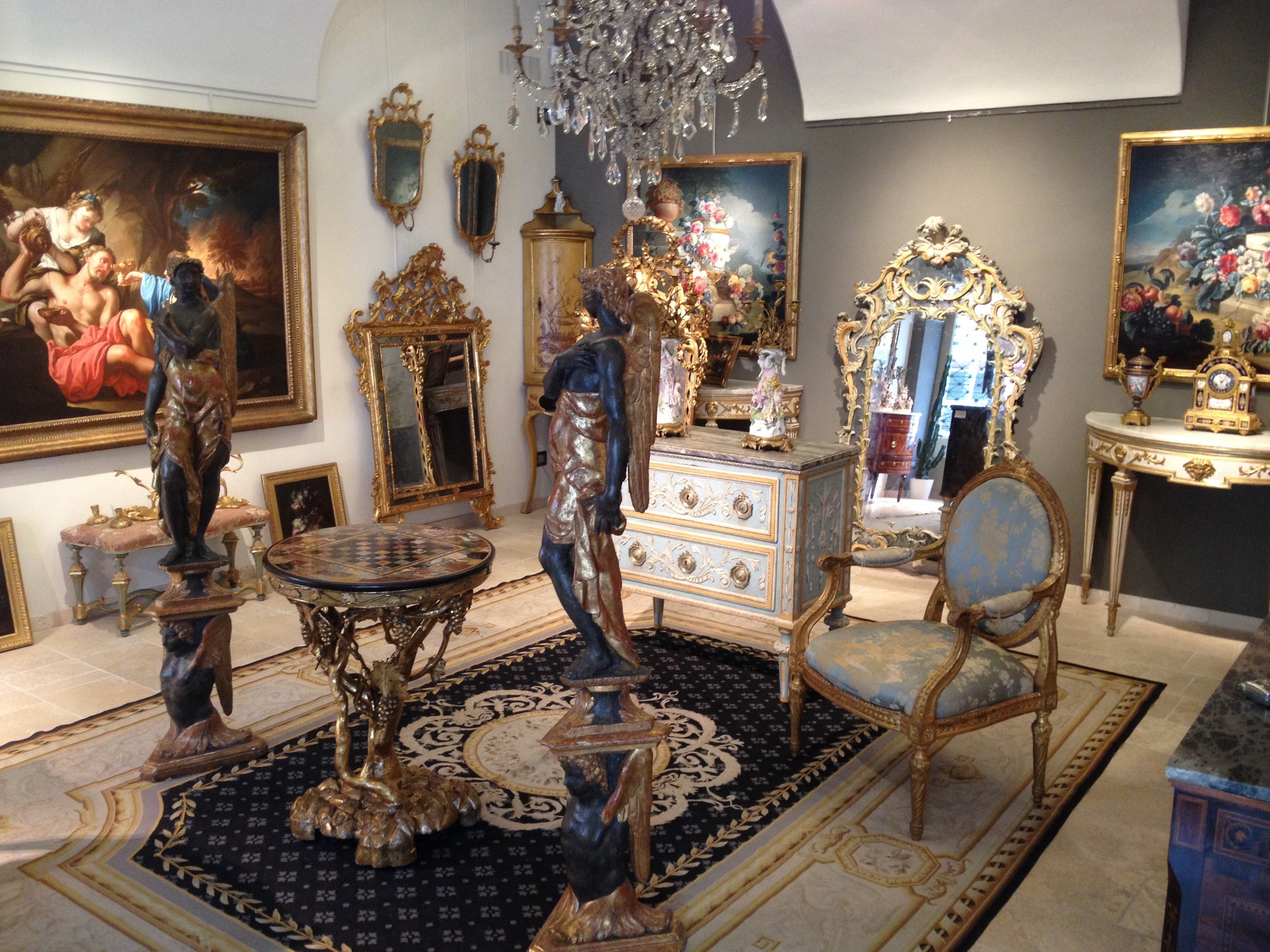
About the Seller
5.0
Platinum Seller
Premium sellers with a 4.7+ rating and 24-hour response times
Established in 1980
1stDibs seller since 2019
54 sales on 1stDibs
Typical response time: <1 hour
- ShippingRetrieving quote...Shipping from: Italy
- Return Policy
Authenticity Guarantee
In the unlikely event there’s an issue with an item’s authenticity, contact us within 1 year for a full refund. DetailsMoney-Back Guarantee
If your item is not as described, is damaged in transit, or does not arrive, contact us within 7 days for a full refund. Details24-Hour Cancellation
You have a 24-hour grace period in which to reconsider your purchase, with no questions asked.Vetted Professional Sellers
Our world-class sellers must adhere to strict standards for service and quality, maintaining the integrity of our listings.Price-Match Guarantee
If you find that a seller listed the same item for a lower price elsewhere, we’ll match it.Trusted Global Delivery
Our best-in-class carrier network provides specialized shipping options worldwide, including custom delivery.More From This Seller
View All17th Century, Pair Italian Paintings Architectural Capriccio by Alberto Carlieri
By Alberto Carlieri
Located in IT
17th century, Pair of paintings depicting Architectural Caprices with Bacchanal and Sacrifice Scene, Alberto Carlieri (Rome 1672-1720)
Oil on canvas; Dimensions: canvas cm H 73.5 x W...
Category
Antique Late 17th Century Italian Baroque Paintings
Materials
Canvas
$80,022 Sale Price
20% Off
17th Century, Italian Painting with Battle Between Christian and Turkish Cavalry
Located in IT
17th century, Italian oil on canvas painting with battle between Christian and Turkish cavalry
The oil on canvas painting depicts a battle between Christian and Turkish cavalry. C...
Category
Antique Mid-17th Century European Baroque Paintings
Materials
Canvas
$32,950 Sale Price
20% Off
17th Century, Italian Painting with Virgin and Child by Follower of Van Dyck
By Anthony van Dyck
Located in IT
17th century, Italian painting with virgin and childr by Follower of Sir Anthony van Dyck
cm W 90 x H 113; cornice cm W 111 x H 135 x D 7
The canvas depicts the Madonna with the Chi...
Category
Antique Late 17th Century Italian Baroque Paintings
Materials
Canvas
17th Century, Italian Painting with Still Life with Fruit, Dogs and Cat
Located in IT
17th Century, Italian painting with still life with fruit, dogs and cat
Measurements: With frame cm W 93 x H 75.5 x D 4; Frame cm W 82.5 x H 66.5
The...
Category
Antique 17th Century Italian Baroque Paintings
Materials
Canvas
$17,416 Sale Price
20% Off
17th Century, Italian Painting with Battle attributed to Marzio Masturzo
Located in IT
Marzio Masturzo, attributed (Active in Italy - in Naples and Rome- in the second half of the 17th century)
"Battle between cavalry and vessels with fortified city on the left"
...
Category
Antique Late 17th Century Italian Baroque Paintings
Materials
Canvas
$39,716 Sale Price
25% Off
17th Century, Italian Painting Saint Jerome Hears the Trumpet of Judgment
Located in IT
Saint Jerome Hears the Trumpet of Judgment, Neapolitan School, 17th Century
This exquisite oil-on-canvas painting depicts Saint Jerome hearing the trumpet of the angel of the Last Ju...
Category
Antique 17th Century Italian Baroque Paintings
Materials
Canvas
You May Also Like
Francesco Graziani, Called Ciccio Napoletano, 17th Century
By Francesco Graziani
Located in CH
Francesco Graziani, Called Ciccio Napoletano, 17th Century
He was active in Naples and Rome around the second half of the 17th Century.
Category
Antique Late 17th Century Italian Baroque Paintings
Materials
Canvas
17th Century Painting
Located in Miami, FL
17th century painting
J.Castano
17th century
Spain
Category
Antique 17th Century Baroque Paintings
Materials
Canvas
$25,000
Italian Francesco or Pietro Graziani Neapolitan battle scene, 17th/18th Century
Located in CH
Italian Francesco or Pietro Graziani Neapolitan battle scene, 17th/18th Century
This battle scene is attributable to one of the two Graziani ( Francesco or Pietro) battle scene pain...
Category
Antique Late 17th Century Italian Baroque Paintings
Materials
Canvas
17th Century Onorio Marinari Italian Religious Painting
By Onorio Marinari
Located in Roma, IT
A very important painting by the great artist of the Florentine school, Onorio Marinari.
Dr. Silvia Benassai has confirmed Marinari’s authorship of the Saint Margaret of Antioch; available on demand, a historical-artistic fact sheet prepared by Dr. Silvia Benassai
Onorio Marinari (1627 – 5 January 1715) was a very important Italian painter and printmaker of the Baroque period, active mainly in Florence.
His father, Sigismondo di Pietro Marinari, was also a painter, and he trained with his cousin, Carlo Dolci, later being also influenced by Simone Pignoni and Francesco Furini.
His fresco in the Palazzo Capponi, Florence, is dated 1707. He worked mainly in Florence for Florentine and Tuscan clients, but he did not devote himself only to painting.
In fact, in 1674, he published an essay on astronomy entitled Fabbrica ed uso dell' Annulo Astronomico. Bartolomeo Bimbi was one of his pupils.
St. Margaret of Antioch
July 20, Martyr
Margaret, known as Margaret of Antioch in the West, and as Saint Marina...
Category
Antique Mid-17th Century Italian Baroque Paintings
Materials
Canvas, Wood
17th Century Oil on Canvas Italian Religious Painting Holy Family, 1660
Located in Vicoforte, Piedmont
Antique Italian painting from the 17th century. Oil on canvas artwork depicting a wonderful Holy Family. Painting of remarkable pictorial quality, particularly evident in the masterf...
Category
Antique 1660s Italian Paintings
Materials
Canvas
17th Century Italian Painting with Angel Wing Frame and 17th Century Arm
By Interi
Located in Dublin, Dalkey
Titled "Vulnerabilita" by Jean O'Reilly Barlow
A 17th century Italian painting with a hand-carved 17th century arm. It is framed with 17...
Category
Antique 17th Century Italian Rococo Paintings
Materials
Quartz, Rock Crystal, Iron
$4,900 Sale Price
30% Off
